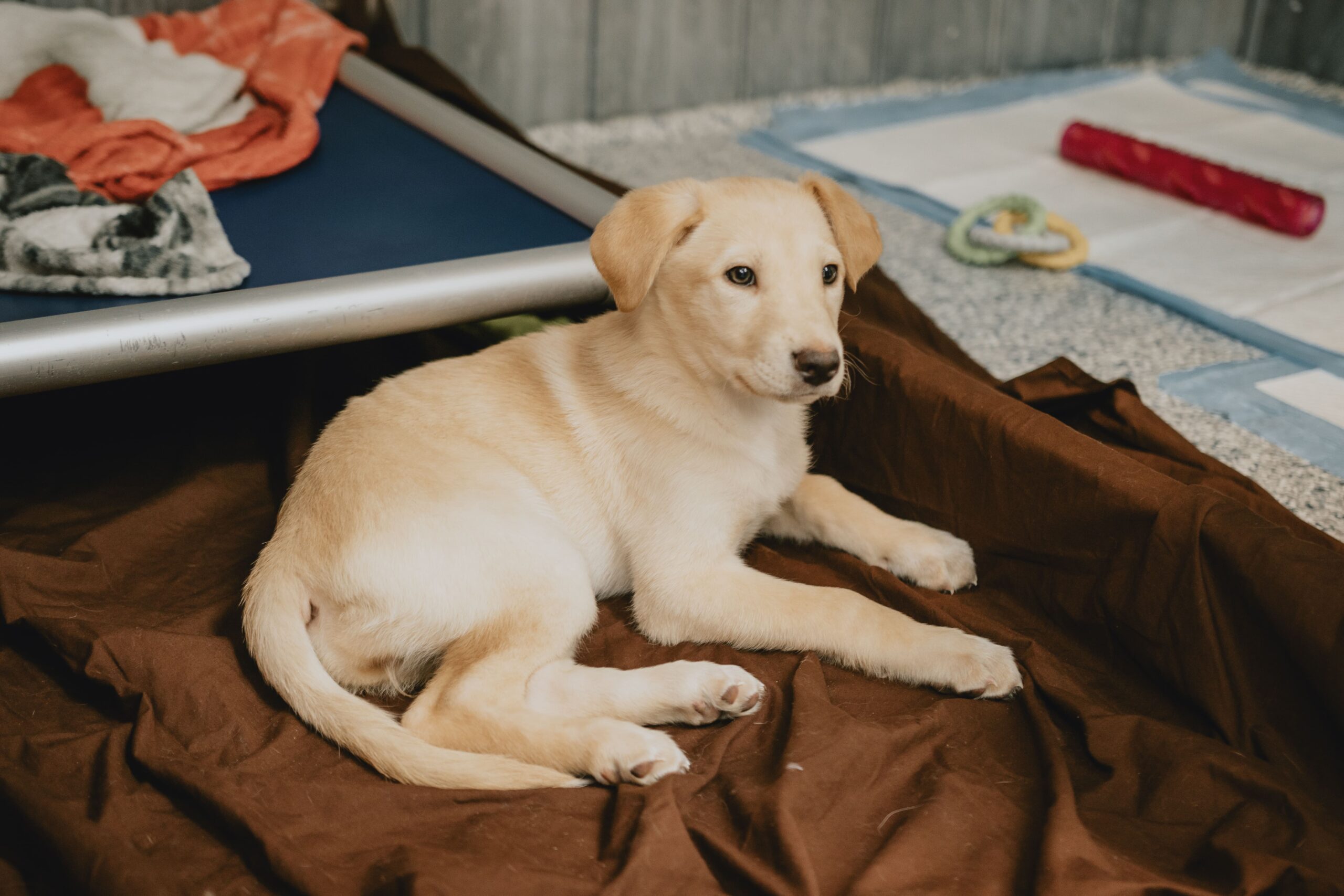The Paw-fect Start: 7 Must-Haves for Your New Puppy
by Ontario SPCA and Humane Society | Dog Care | January 5, 2024

Guest blog by Dr Emmanuel Fontaine, Scientific Communications Veterinarian at Royal Canin North America
Bringing home a new puppy is a thrilling experience, marking the beginning of an unforgettable bond between you and your furry friend. But amid the excitement, it’s crucial to set the stage for a harmonious relationship by preparing your home for your pup’s arrival. In this guide, we take a fresh look at the 7 essential steps to ensure a smooth transition for both you and your puppy. From selecting the perfect bowls to establishing a healthy diet, our blog will provide you with valuable insights and practical tips. Let’s embark on this amazing journey together, creating a loving and nurturing environment for your newest family member.
#1 Choosing the Perfect Food and Water Bowls: The Unsung Heroes of Mealtime
It’s easy to overlook the importance of food and water bowls amidst the excitement of bringing home a new puppy. However, these humble vessels play a critical role in your pup’s daily life, contributing to their overall health and well-being. By opting for stainless steel bowls, you not only ensure durability and hygiene but also create a comfortable eating environment for your furry companion.
There are various types of bowls available on the market, including plastic, ceramic, and stainless steel. Plastic bowls may be lightweight and inexpensive, but they can harbor bacteria and develop scratches over time. Ceramic bowls, while visually appealing, can be heavy and prone to chipping or breaking. Stainless steel bowls, on the other hand, are the gold standard for their durability, cleanliness, and ability to withstand wear and tear.
When it comes to placement, consider finding a quiet, low-traffic area in your home where your puppy can enjoy their meals without distractions. To prevent spills and make cleaning easier, you can also invest in non-slip mats or elevated feeding stations.
Regular cleaning of your puppy’s bowls is crucial to prevent the growth of harmful bacteria. Opt for a mild, pet-safe detergent, and scrub the bowls daily to ensure your pup’s eating area remains clean and sanitary. By dedicating time and thought to this often-overlooked aspect of puppy care, you’ll be taking a crucial step toward raising a healthy and happy companion.
#2 Selecting a Comfortable and Suitable Bed for Your Puppy: The Foundation of Sweet Dreams
A cozy sleeping area is a sanctuary for your puppy, providing them with a safe space to rest and recharge. By carefully considering elements like size, material and future growth, you’ll create a comforting haven for your furry friend that promotes relaxation and contentment.
When it comes to types of beds, there’s no shortage of options: cushions, blankets, kennels, and crates are all viable choices. The key is to determine which option will best suit your puppy’s needs, taking into account their breed, temperament, and sleeping habits. For instance, some puppies prefer to burrow and nest, making a plush, cushioned bed an ideal choice. Others may require the security and structure provided by a crate or kennel.
One crucial aspect to consider when selecting a bed is your puppy’s future size as an adult. This foresight will ensure you invest in a bed that can comfortably accommodate them as they grow. Additionally, don’t forget to factor in the bed’s ease of cleaning, as a washable and durable material will make maintaining your pup’s sleeping area a breeze.
Placement of your puppy’s bed is just as important as the bed itself. Choose a quiet, draft-free location that allows your puppy to feel secure while still being part of the household. By thoughtfully selecting and positioning your puppy’s bed, you’ll contribute to their overall well-being, setting the stage for many sweet dreams to come.
#3 Assembling a Comprehensive Grooming Kit: The Art of Puppy Pampering
Grooming your puppy is more than just a beauty routine; it’s an essential aspect of their overall health and well-being.
A well-rounded grooming kit typically includes a comb, nail trimmer, scissors, and clippers. Each tool serves a unique purpose in maintaining your puppy’s hygiene and appearance. Combs and brushes help detangle fur, remove loose hair, and distribute natural oils, promoting a healthy coat. Nail trimmers keep your pup’s claws at a comfortable length, preventing discomfort and potential injuries. Scissors and clippers are useful for trimming excess fur around the face, paws, and other sensitive areas.
Integrating regular grooming sessions into your puppy’s routine offers a range of benefits. It familiarizes your pup with handling, making future vet visits and grooming appointments less stressful. Additionally, grooming provides an opportunity to inspect your puppy for any hidden wounds, parasites, or skin issues, ensuring they receive timely care if needed.
To create a positive grooming experience for both you and your puppy, approach each session with patience and positivity. Start slow, introducing one tool at a time, and reward your puppy with praise and treats for their cooperation. By cultivating a nurturing and attentive grooming routine, you’ll enhance your bond with your pup while keeping them looking and feeling their best.
#4 Stocking Up on Fun and Educational Toys: The Secrets of Playtime Enrichment
Toys are more than just playful distractions; they play a pivotal role in your puppy’s mental and physical development.
A diverse toy collection should include chew toys, interactive toys, puzzle toys, and soft toys. Chew toys offer a safe outlet for your puppy’s natural urge to gnaw, supporting dental health and alleviating teething discomfort. Interactive toys, such as tug ropes and fetch balls, encourage physical activity and social interaction. Puzzle toys challenge your pup’s cognitive abilities, keeping them mentally stimulated and engaged. Soft toys provide comfort and companionship, especially when you’re not around.
Safety should always be a top priority when choosing toys for your puppy. Opt for rubber toys that are at least twice the size of your puppy’s mouth to minimize the risk of choking. Regularly inspect toys for wear and tear, discarding any that are broken or have loose parts.
To keep your puppy’s interest piqued, consider rotating their toys every few weeks. This rotation will help prevent boredom and ensure each toy remains novel and exciting. Lastly, remember to clean your pup’s toys regularly to maintain a hygienic play environment. By thoughtfully curating and managing your puppy’s toy collection, you’ll foster a fun and enriching playtime experience that contributes to their overall well-being.
#5 Choosing the Right Collar or Harness and Leash: The Path to Harmonious Walks
Walks are an integral part of your puppy’s life, offering exercise, mental stimulation, and opportunities for socialization. Ensuring your pup is equipped with the right collar or harness and leash is crucial for creating a safe and enjoyable walking experience.
Collars and harnesses come in various styles, including flat collars, martingale collars, front-clip harnesses, and back-clip harnesses. Consult your veterinarian or a trusted professional for recommendations tailored to your puppy’s specific needs. Factors such as breed, size, and walking behavior will influence which style is best suited for your pup.
When selecting the right size and style, prioritize comfort and adjustability. Ensure the collar or harness fits snugly without causing discomfort or restricting movement. A properly fitted walking aid should allow you to slip two fingers between the collar or harness and your puppy’s skin.
Introducing your puppy to their collar or harness and leash is a gradual process. Begin by letting them wear the collar or harness around the house, rewarding them with praise and treats for their cooperation. Progress to short, leashed walks in the backyard or garden, gradually increasing the duration and distance as your pup becomes more comfortable and confident.
By investing time and care into selecting and introducing your puppy’s walking gear, you’ll pave the way for countless enjoyable walks and adventures, fostering a strong bond between you and your four-legged companion.
#6 The Essentials of a Puppy Travel Carrier: Safeguarding Your Furry Adventurer
Whether you’re planning road trips, visits to the vet, or other excursions with your new puppy, a travel carrier is an indispensable tool for keeping your furry friend safe and secure.
Travel carriers come in various styles, including soft-sided carriers, hard-sided carriers, and wearable options like slings and backpacks. When choosing the right carrier, consider factors such as your puppy’s size, breed, and temperament, as well as your mode of transportation and the frequency of your trips. A well-ventilated, sturdy, and easy-to-clean carrier is a wise investment for any puppy parent.
When introducing your pup to their carrier, patience is key. Create a welcoming environment by placing a soft blanket, familiar toy, or treat inside the carrier. Allow your puppy to explore the carrier at their own pace, rewarding their curiosity with praise and encouragement. Gradually increase the duration of time your puppy spends inside the carrier, eventually incorporating short trips to help them acclimate to the experience.
At home, a travel carrier can double as a protective space for adventurous puppies, offering a safe retreat when needed. By thoughtfully selecting and introducing your puppy’s travel carrier, you’ll equip them for a lifetime of safe, comfortable, and enjoyable journeys with you by their side.
#7 Nourishing Your Puppy with the Right Diet: The Cornerstone of a Healthy Start
Proper nutrition is fundamental to your puppy’s growth and development, laying the groundwork for a healthy and happy life.
Puppies require a unique blend of nutrients, including proteins, fats, carbohydrates, vitamins, and minerals, to support their rapid growth and development. A high-quality, commercial puppy food tailored to your pup’s specific breed and size will typically meet these requirements. Consult with your veterinarian or trusted professional to identify the best food for your puppy’s needs and learn the appropriate portion sizes and feeding frequency.
When transitioning your puppy to a new diet, do so gradually to avoid digestive upset. Over the course of a week, slowly mix increasing amounts of the new food with the old food until your puppy is fully adjusted.
In addition to providing a balanced diet, be mindful of your puppy’s weight and growth rate. Regular weight checks and veterinary visits will help you monitor their progress and make adjustments as needed. Avoid feeding table scraps, as this can lead to unbalanced nutrition and poor eating habits.
By prioritizing your puppy’s dietary needs from day one, you’ll set the stage for a lifetime of health, vitality, and well-being. Nourishing your pup with the right diet is an essential investment in their future happiness and longevity.
The arrival of a new puppy is an exciting and rewarding journey, filled with precious moments, love, and companionship. However, it is crucial to be well-prepared and equipped with the essentials to ensure a smooth transition and a nurturing environment for your furry friend. By diligently following the recommendations outlined in this comprehensive guide, you’ll be well on your way to creating a welcoming and supportive home for your new family member.
Remember, raising a puppy requires patience, understanding, and a commitment to their growth and development. As you navigate the challenges and joys of puppy parenthood, keep in mind that your efforts will be rewarded with a lifetime of unconditional love, loyalty, and companionship from your four-legged friend.
 Emmanuel Fontaine graduated from the Toulouse Veterinary School in 2004, he continued his studies at the Alfort Veterinary School (Paris) as trainee Vet in the domestic carnivore unit of the Reproduction Department. From 2005 to 2011, he worked at the Centre d’Etude en Reproduction des Carnivores (CERCA) [Research Centre for Reproduction in Carnivores], a unit specializing in pet breeding assistance. Emmanuel Fontaine is also qualified at the European College for Animal Reproduction (ECAR) and completed his PhD in 2012 on the use of GnRH agonists in canines. From September 2011 to September 2018, he worked as Technical Services Veterinarian for the PRO team at Royal Canada. He then was in charge of Scientific Communication for the Americas until August 2022. He now works as Senior Scientific Communications Veterinarian for Royal Canin North America.
Emmanuel Fontaine graduated from the Toulouse Veterinary School in 2004, he continued his studies at the Alfort Veterinary School (Paris) as trainee Vet in the domestic carnivore unit of the Reproduction Department. From 2005 to 2011, he worked at the Centre d’Etude en Reproduction des Carnivores (CERCA) [Research Centre for Reproduction in Carnivores], a unit specializing in pet breeding assistance. Emmanuel Fontaine is also qualified at the European College for Animal Reproduction (ECAR) and completed his PhD in 2012 on the use of GnRH agonists in canines. From September 2011 to September 2018, he worked as Technical Services Veterinarian for the PRO team at Royal Canada. He then was in charge of Scientific Communication for the Americas until August 2022. He now works as Senior Scientific Communications Veterinarian for Royal Canin North America.
Categories
Testimonial
Thank you so much for all you do
Thank you so much for all you do every day to rescue animals in need. I can’t imagine the terrible situations that you see every day. It is great that you have the heart to help. Keep up the good work.
